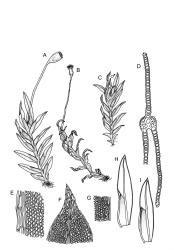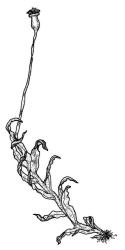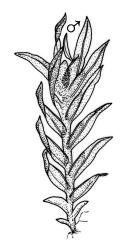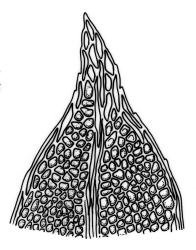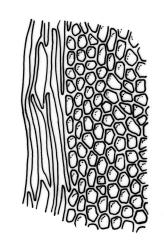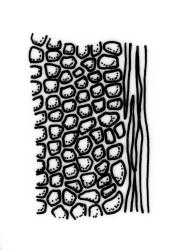- = Fissidens cheesemanii Geh. in Müller, Gen. Musc. Frond. 59 (1900) nom. inval.
- = Fissidens gonioneurus Müll.Hal., Gen. Musc. Frond. 59 (1900) nom. inval.
- = Fissidens leptocladus var. cheesemanii Dixon, Bull. New Zealand Inst. 3: 101 (1923)
- = Fissidens leptocladus subsp. gonioneurus Dixon, Bull. New Zealand Inst. 3: 102 (1923)
- = Fissidens obscurifolius Dixon, Bull. New Zealand Inst. 3: 101 (1923) nom. illeg.
- = Fissidens variolimbatus Allison, Trans. Roy. Soc. New Zealand, Bot. 2: 138 (1963) – as variolimbata
Plants 3–15 mm, yellow-green to dark green, densely gregarious. Stems simple or occasionally branched, rhizoids at shoot and branch bases. Leaves in 4–30(–45) pairs, patent to patulous, often undulate and decurved when moist, irregularly crispate when dry, linear-lanceolate, lanceolate, or oblong-ovate, 1.0–1.6 × 0.2–0.4 mm; apex acute; laminae unistratose; vaginant laminae ½–⅔ leaf length; closed; dorsal lamina reaching leaf insertion and sometimes shortly decurrent; margins minutely serrulate at apex, otherwise entire; marginal cells on all laminae distinct in several rows, thick-walled, prosenchymatous forming a unistratose to pluristratose border failing only near leaf apex and base of dorsal lamina, or occasionally less extensive on all laminae, or, rarely, fusing with costa at leaf apex, wider on vaginant laminae and occasionally intramarginal proximally; cells of apical and dorsal laminae quadrate to hexagonal, smooth, moderately bulging, obscure, with moderately thick walls, (5.0–)6.0–7.5(–9.0) × 6.0–9.0 µm. Costa sub-percurrent to percurrent, bryoides-type in cross-section.
Dioicous. Perichaetia terminal; perichaetial leaves longer and narrower than vegetative leaves. Perigonia terminal on unbranched plants with 3–7 pairs of leaves. Setae straw-coloured to orange-brown, 3–4 mm; capsules inclined, symmetric, 0.6–1.0 mm; operculum obliquely rostrate from a conic base, ½ the length of theca. Peristome bryoides-type; teeth with adaxial trabeculae smooth, or with long-columnar papillae, 30–54 µm wide at base. Calyptra smooth, cucullate. Spores 11–17(–19) µm.
Dixon 1923, pl. 7, fig. 1; Allison 1963, fig. 3 (as F. variolimbata); Scott & Stone 1976, pls 7–9 (pro parte); Catcheside 1980, fig. 12; Beever et al. 2002, p. 38, figs 1–6; Stone & Catcheside 2012.
Fissidens leptocladus is extremely variable in size (3–15 mm), leaf shape, and in extent and robustness of its laminal borders. The variability of the species is reflected in the synonymy listed above.
Forms of F. leptocladus with lanceolate or linear-lanceolate leaves are very common; less common are those with oblong-ovate leaves. These are similar to type material of the Australian endemic F. patulifolius Dixon, a species which I.G. Stone regarded as having a continuum of forms with F. leptocladus (I.G. Stone, pers. comm., Oct. 1992). In N.Z. such oblong-ovate leaved forms have been confused with F. bryoides. Features distinguishing them are given under that species.
Typically laminal borders fail before the leaf apex in F. leptocladus, but rare forms occur in which borders fuse with the costa, which is then excurrent as an apiculus (e.g., A.R. Gardiner s.n., AK 348572). These can be distinguished from F. curvatus by their smaller, bulging, and hence more obscure lamina cells. Confusion with F. waiensis may occur, but, in the typical form of that species, if borders are present they are confined to the vaginant laminae, and laminae are partially pluristratose. Puzzling forms with larger leaf cells are also found (e.g., P. de Lange 11467, AK 349109).
Plants of F. leptocladus in seeps cannot be distinguished with certainty from small forms of F. rigidulus var. rigidulus in the absence of mature capsules (and capsules are rarely present in that habitat). Spores of F. leptocladus are generally smaller (spores 11–17(–19) µm vs 17–20 µm in F. rigidulus var. rigidulus). Sainsbury’s (1955) suggestion that the "strong cartilaginous border" of F. rigidulus would prevent confusion with F. leptocladus applies only to typical forms. Bruggeman-Nannenga (1979, p. 16) gives a table of differences between the two taxa, but the small regions of overlap (in leaf length and border width) still preclude identification of troublesome specimens.
Confusion of F. leptocladus with F. anisophyllus has occurred; differences are described under the latter species.
The circumscription of this highly variable species might well be clarified by molecular study.
K; NI: N Auckland, including offshore islands (TK, PK, HC, LB, GB, RT), S Auckland, Gisborne, Hawke’s Bay, Taranaki, Wellington (including KA); SI: Nelson (including D’U), Marlborough, Canterbury, Westland, Otago, Southland; St; Ch; A; C.
Austral. Tasmania*, mainland Australia*, Chile*.
Fissidens leptocladus is a very common species, on soil or rock (especially on calcareous substrates), in a diversity of indigenous and exotic vegetation types, from coastal rock with scattered halophytes to alpine tussock grasslands. It grows as a mesophyte and as a hygrophyte. It has also been found growing permanently submerged at 1 m or more depth in cold, clear water, in association with F. berteroi. at Te Waihou Springs, S Auckland L.D. (P.J. de Lange 11867, AK 348725). Fissidens leptocladus is tolerant of a wide range of light intensities: it is one of the more shade tolerant of N.Z. Fissidens species, growing at very low light intensities in the mouths of caves, but is also common in exposed coastal seeps. Frequent associates include F. curvatus and F. tenellus var. tenellus.
Most collections are from between sea level and 1000 m, but it has been recorded from as high as c. 1650 m (Mt Arthur, Nelson L.D.).
Although the type of F. leptocladus var. gonioneurus has not been located, the description by Dixon (1923, p. 102) suggests it most appropriately belongs here, in spite of his conclusion to the contrary. The type material was said by Dixon to be held between mica sheets and to be without capsules. Dixon understatedly noted "it was not easy to determine the position of the leaves when dry, but I believe them to be scarcely altered; this would give them a very marked distinction from F. leptocladus".




